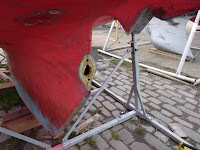The story of the
Fettler continues...
Winter is over and the last few weeks leading up to lift-in have been characterised by feverish preparations. The big one was the unexpected job that came to light after lift-out last autumn, when I noticed a nasty looking crack at the bottom end of the rudder. There was some debate during the winter over whether it would be necessary to take the rudder off in order to make a proper repair. Actually, that's not quite true. It was obvious that the rudder would have to come off. The problem was that the rudder can only come off when the boat is 5 or 6 feet up in the air.
Facilities in our harbour don't stretch to a resident crane or travel hoist, so lifting boats, apart from when the big crane is hired for lifting everybody out or in, is quite a challenge.
I eventually managed to sort out the hire of a big machine to come and lift the boat up twice - once for taking the rudder off, and again a few weeks later to put it back on, leaving 1 week to get everything back together for lift-in.

This was the way the damage at the base of the rudder looked, after some cleaning up with the grinder. You can see the stainless steel tang, that had originally been bonded in place, sitting on top of the rudder. That's the part on which the rudder pivots. It simply dropped out when we removed the rudder and that was when I knew that this repair was worth all the hassle.

We
thought that dropping the rudder would be fairly straightforward, once the propeller and prop shaft were removed. Sadly, it was not to be. No way, no how would the rudder shaft clear the outer end of the stern bearing (the bit where the prop shaft passes through the hull). I had to act quickly, so grabbed the grinder out of the back of the van and ground the glass away from the top end of the rudder, right down to the shaft. This allowed us to remove the rudder, but at the expense of a bent flange on the stern bearing (luckily Robin, fellow club member and retired engineer, had the kit and expertise to straighten this out without fuss).

The rudder came home with us on the top of the van and the spare bedroom became the workshop.
Back at the yard, the vessel was left rudderless for the first time in many, many years.



 How sexy is that?
How sexy is that?












